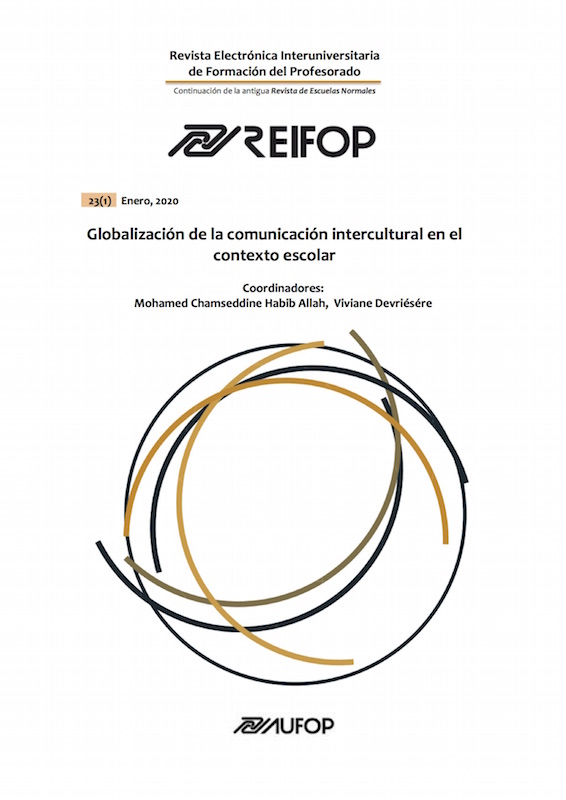Exploring intercultural communication online: Video annotation in teacher education
Abstract
In post-Web 2.0, the role of video has become increasingly important, both in e-learning and in blended learning systems. This article aims to identify how video annotation can help explore communication in teacher training. With the necessity to take into account the great diversity of pupils, collaborative work and online exchanges may help increase understanding of intercultural communication. Firstly, we begin with a presentation of collaborative video annotation to observe the place and the role of interaction in this system. Then, we seek to uncover elements of the design process in a design-based research project on Celluloid, a video annotation device through the description of two experiments: their contexts, the videos used, the consultation modalities and the annotation processes developed to increase interaction.
Downloads
-
Abstract852
-
PDF (Español (España))529
References
Albero, B. (2013). L’analyse de l’activité en sciences de l’éducation : entre aspirations scientifiques et exigences pragmatiques. Travail et Apprentissages, 12, 94-117.
Albero, B. & Guérin, J. (2014). L’intérêt pour l’‘activité’ en sciences de l’éducation. Vers une épistémologie fédératrice ? (Note de Synthèse). TransFormations : Recherches en éducation et formation des adultes, Institut CUEEP, Lille 1, 11, 11-44.
Bourgatte, M. & Tessier, L. (2018a). Les outils d’annotation vidéo pour la recherche. In É. Cavalié, F. Clavert, O. Legendre, & D. Martin (Éd.), Expérimenter les humanités numériques : Des outils individuels aux projets collectifs (p. 19 35). Canada, Montréal : Presses de l’Université de Montréal.
Bourgatte, M. & Tessier, L. (2018b). Celluloid : usages de la vidéo pour l’enseignement et annotation collaborative [Billet]. Document accessible à l’adresse suivante : https://celluloid.hypotheses.org/1178, consulté le 05 décembre 2018.
Brunvand, S. (2010). Best practices for producing video content for teacher education. Contemporary Issues in Technology and Teacher Education, 10(2), 247-256.
Charlier, B., Deschryver, N., & Peraya, D. (2006). Apprendre en présence et à distance. Distances et savoirs, 4(4), 469 496.
Dervin, F. (2016). Interculturality in education: A theoretical and methodological toolbox. Springer.
Dewey, J. (1938). Experience and Education. USA, New York: Macmillan Company.
Erickson, F. (2007). Ways of seeing video: Toward a phenomenology of viewing minimally edited footage. Video research in the learning sciences, 145-155.
Gaudin, C. & Chaliès, S. (2012). L’utilisation de la vidéo dans la formation professionnelle des enseignants novices. Revue française de pédagogie, 178, 115-130.
Hoadley, C. & al. (2003). Design-Based Research: An Emerging Paradigm for Educational Inquiry. Educational Researcher, 32(1), 5 8.
Holliday, A. (2018). Designing a course in intercultural education. Intercultural Communication Education, 1(1), 4-11.
Le Deuff, O. L. (2012). Littératies informationnelles, médiatiques et numériques : de la concurrence à la convergence ? Études de communication. Langages, information, médiations, 38, 131 147.
Lebrun, M., Lecoq, J., & Becchetti-Bizot, C. (2015). Classes inversées : enseigner et apprendre à l’endroit ! France, Poitiers : Canopé éditions.
Linard, M. (1989), (1996, nouv. éd. réactualisée). Des machines et des hommes. Apprendre avec les nouvelles technologies. France, Paris : l'Harmattan.
Mabillot, V. (2012). Le wiki : un dispositif d’écriture « émergente » publique et coopérative ? Communication & langages, 174(4), 69 84.
Mercklé, P. (2016). Les réseaux sociaux en ligne : une révolution ? Repères, 71 94.
Mezirow, J. (2001). Penser son expérience : une voie vers l’autoformation. France, Paris : chronique sociale.
Peraya, D. (2017). Au centre des Mooc, les capsules vidéo : un renouveau de la télévision éducative ? Distances et médiations des savoirs, 17. Document accessible à l’adresse suivante : http://journals.openedition.org/dms/1738, consulté le 05 décembre 2018.
Rallet, A., Rochelandet, F., & Zolynski, C. (2015). De la Privacy by Design à la Privacy by Using. Réseaux, 189(1), 15 46.
Sanchez, E. & Monod-Ansaldi, R. (2015). Recherche collaborative orientée par la conception. Education & didactique, 9(2), 73 94.
Sweller, J. (1994). Cognitive Load Theory, learning difficulty, and instructional design. Learning and Instruction, 4, 295–312.
Theureau, J. (2015). Le cours d’action : l’enaction & l’expérience. France, Toulouse : Octares.
Tremion, V., & Dervin, F. (2018). De Cultura aux MOOCs de communication interculturelle: quelles opportunités pour l’apprentissage interculturel à distance? International Journal of E-Learning & Distance Education/Revue internationale du e-learning et la formation à distance, 33(1).
Trémion, V. (2019). Etude de représentations sur les innovations en classe inversée à l’université. Spirale, 63, 11-21.
Tricot, A. & Amadieu, F. (2014). Apprendre avec le numérique : mythes et réalités. France, Paris : Retz.
Vygotski, L. S. (1978). Internalization of higher psychological functions. Mind in society. USA, Cambridge, Massachusetts: Harvard University Press.
Los artículos que se publican en esta revista están sujetos a los siguientes términos:
1. El Departamento de Métodos de Investigación y Diagnóstico en Educación de la Universidad de Murcia (España), junto con el Servicio de Publicaciones de la Universitdad de Murcia (Editum) son los editores de la revista REIFOP y conserva los derechos patrimoniales (copyright) de los artículos publicados, permitiendo la reutilización de las mismos bajo la licencia de uso indicada en el punto 2.
2. Las obras se publican en la edición electrónica de la revista bajo una licencia Creative Commons Reconocimiento-NoComercial-SinObraDerivada 3.0 España (texto legal). Se pueden copiar, usar, difundir, transmitir y exponer públicamente, siempre que: i) se cite la autoría y la fuente original de su publicación (revista, editores y URL de la obra); ii) no se usen para fines comerciales; iii) se mencione la existencia y especificaciones de esta licencia de uso.
3. Condiciones de auto-archivo. Se permite y se anima a los autores a difundir electrónicamente las versiones pre-print (versión antes de ser evaluada) y/o post-print (versión evaluada y aceptada para su publicación) de sus obras antes de su publicación, ya que favorece su circulación y difusión más temprana y con ello un posible aumento en su citación y alcance entre la comunidad académica. Color RoMEO: verde.















